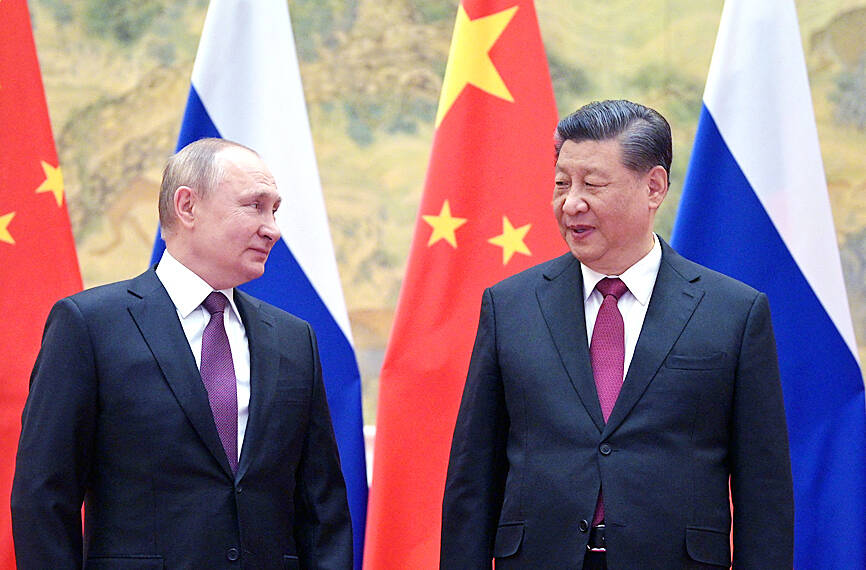Russia has found itself in an unequal relationship with China since intensifying its pivot toward Beijing after the assault on Ukraine.
Since Western countries imposed sanctions on Moscow, bilateral trade between the two neighbors has reached a record US$190 billion, and the proportion of Russian foreign trade carried out in yuan has gone from 0.5 percent to 16 percent.
“It’s absolutely critical for Russia to be close to China, because Russia doesn’t have many trade friends,” Institute of International Finance deputy chief economist Elina Ribakova said.

Photo: AFP
Russian President Vladimir Putin is preparing to host Chinese President Xi Jinping (習近平) this week.
The two last met when Putin visited Beijing three weeks before launching the invasion of Ukraine.
Ties between the two countries are particularly strong in the energy sector, which has been heavily targeted by Western sanctions.
“China and India have replaced the European Union as Russia’s most important [oil] export market,” a group of economists from the Institute of International Finance said in a report.
Along with Turkey, China and India accounted for two-thirds of Russia’s crude oil exports in the fourth quarter of last year.
“Chinese companies took over the niches that were freed by Western companies that exited Russia,” said Sergey Tsyplakov, an expert at the Moscow Higher School of Economics.
That was a view shared by Anna Kireeva, a research fellow at the Moscow State Institute of International Relations.
“It was necessary to find alternative sources of import as well, especially in machinery, electronics, various parts and components, automobiles and other vehicles,” Kireeva said.
However, she said most big Chinese companies that are well-integrated into Western markets opted to pause their activities in Russia for fear of potential sanctions.
Time will tell if the alliance of convenience turns into a long-term sustainable partnership.
“Putin wants an even relationship with China, like with a twin brother, but it’s not the case,” said Timothy Ash, a senior emerging market sovereign strategist at BlueBay Asset Management LLC.
“Russia has no other option” than to turn to China, he added.
Temur Umarov, a fellow at the Carnegie Endowment for International Peace, said Russia’s economic stability “depends on China.”
“It gives Beijing another tool, another instrument to influence Russia from domestically,” he said.
The Kremlin denies any disparity.
“There is neither a leader nor a follower in relations between Russia and China, because both parties trust each other equally,” Russian presidential aide Yuri Ushakov told journalists.
Some logistical problems hinder trade development between Beijing and Moscow. Railway routes in Russia’s eastern regions are saturated, Kireeva said.
Infrastructure in those far eastern regions, including the main oil port of Kozmino in the Sea of Japan, are also congested.
Russia has had to sell its oil at cheaper prices than usual to China or India to maintain sales volumes. Its budget reflects the consequences of the forced discounts.
Oil export revenue sank by 42 percent year-on-year last month, the International Energy Agency said.
Having fewer partners leaves Russia in a vulnerable position compared with China, which remains a competitor, Ash said.
“Beijing has an interest in keeping Russia as an ally that is independent to the West, while it also likes Russia to be weakened so it can exploit it,” he said.
Russia’s economic dependency on China is still in its early stages, Umarov said.
“In years or decades, this economic leverage could turn into some bigger political leverage,” he added.

Shiina Ito has had fewer Chinese customers at her Tokyo jewelry shop since Beijing issued a travel warning in the wake of a diplomatic spat, but she said she was not concerned. A souring of Tokyo-Beijing relations this month, following remarks by Japanese Prime Minister Sanae Takaichi about Taiwan, has fueled concerns about the impact on the ritzy boutiques, noodle joints and hotels where holidaymakers spend their cash. However, businesses in Tokyo largely shrugged off any anxiety. “Since there are fewer Chinese customers, it’s become a bit easier for Japanese shoppers to visit, so our sales haven’t really dropped,” Ito

The number of Taiwanese working in the US rose to a record high of 137,000 last year, driven largely by Taiwan Semiconductor Manufacturing Co’s (TSMC, 台積電) rapid overseas expansion, according to government data released yesterday. A total of 666,000 Taiwanese nationals were employed abroad last year, an increase of 45,000 from 2023 and the highest level since the COVID-19 pandemic, data from the Directorate-General of Budget, Accounting and Statistics (DGBAS) showed. Overseas employment had steadily increased between 2009 and 2019, peaking at 739,000, before plunging to 319,000 in 2021 amid US-China trade tensions, global supply chain shifts, reshoring by Taiwanese companies and

Taiwan Semiconductor Manufacturing Co (TSMC, 台積電) received about NT$147 billion (US$4.71 billion) in subsidies from the US, Japanese, German and Chinese governments over the past two years for its global expansion. Financial data compiled by the world’s largest contract chipmaker showed the company secured NT$4.77 billion in subsidies from the governments in the third quarter, bringing the total for the first three quarters of the year to about NT$71.9 billion. Along with the NT$75.16 billion in financial aid TSMC received last year, the chipmaker obtained NT$147 billion in subsidies in almost two years, the data showed. The subsidies received by its subsidiaries —

Taiwan Semiconductor Manufacturing Co (TSMC) Chairman C.C. Wei (魏哲家) and the company’s former chairman, Mark Liu (劉德音), both received the Robert N. Noyce Award -- the semiconductor industry’s highest honor -- in San Jose, California, on Thursday (local time). Speaking at the award event, Liu, who retired last year, expressed gratitude to his wife, his dissertation advisor at the University of California, Berkeley, his supervisors at AT&T Bell Laboratories -- where he worked on optical fiber communication systems before joining TSMC, TSMC partners, and industry colleagues. Liu said that working alongside TSMC